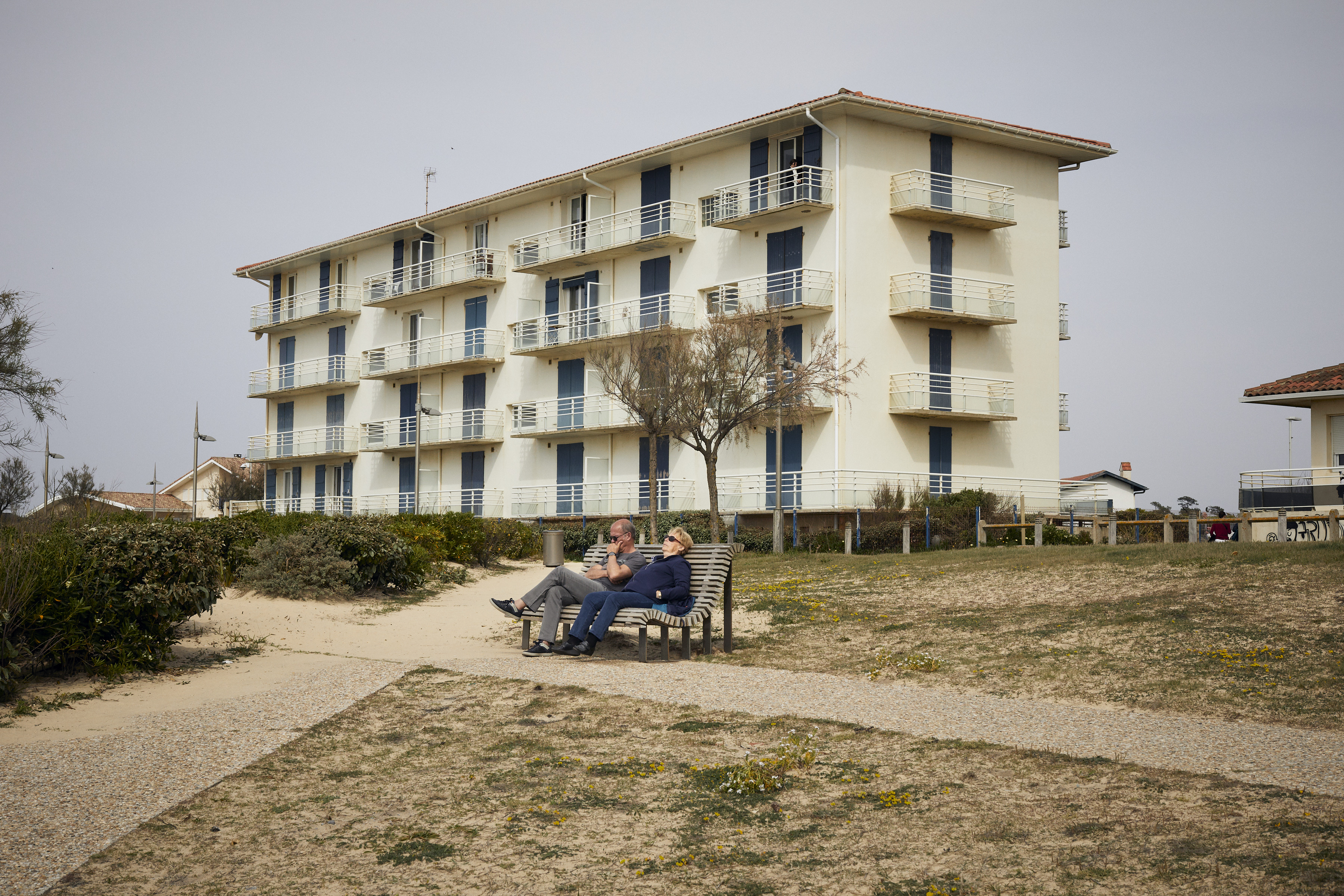
by Neal Rockwell
The Forest of Landes is the largest artificial forest in Western Europe. Located south of Bordeaux, it spans a triangle of nearly a million hectares in the south of the country, running from Soulac at its northernmost point, to Hossegor in the south and Nérac to the east, with its western boundary running along two hundred and twenty-five kilometers of sand dune bordering the Atlantic Ocean. It is by and large a monoculture – the entire forest is made up almost entirely of one species: the maritime pine.
A New World
Before the arrival of the forests in the mid-nineteenth century, Landes was a region of wetlands and bogs. In French, lande means bog or heath. Shepherds tended their flocks wearing stilts to navigate the muddy pasturelands.
The first efforts to create an artificial forest began in the 18th century as a way to control the windswept coastal dunes, which had a tendency to swallow nearby villages. The project to secure the dunes expanded after the revolution and carried on under Napoleon’s reign, but the project accelerated massively during the government of Napoleon III with the passing of the Law of the 19th of June 1857. At the time the wetlands still suffered from malaria, and industry was pressuring the government to grow trees, not for the wood specifically but for the rosin and turpentine that could be produced from the sap. The law made provisions for the draining of swamps and the planting of pines both to attenuate disease and satisfy the needs of industrial expansion, but it was not without controversy. For one, local shepherds relied on an extensive commons to graze their sheep and the law required municipalities to auction the commons to private interests. As the land was privatized, locals were dispossessed of their traditional livelihoods. In the decades following the passage of this legislation many tree farms were burned in retaliation, though without seriously altering the trajectory of these modernizing tendencies. We visited Landes because my girlfriend’s father and his wife bought a retirement home. Nominally, we were helping them move in. The house is in Seignosse about six kilometers from the sea. It is a basic house dating from the 1980s, with a slightly asymmetrical, pitched terracotta tile roof, off-white stucco walls with reddish trim and matching shutters. This style is common to the area. It began in neighbouring Hossegor, where architects building the first vacation homes in the 1920s took inspiration from Basque architecture, the Basque border being situated several kilometers to the south. Hossegor is the main draw to the region, with its famous surfing and stately (and extremely expensive) houses built in the early part of the 20th century. The pines there are more mature, distributed in a more organic fashion around the houses, the hills, the golf course and the downtown high street.
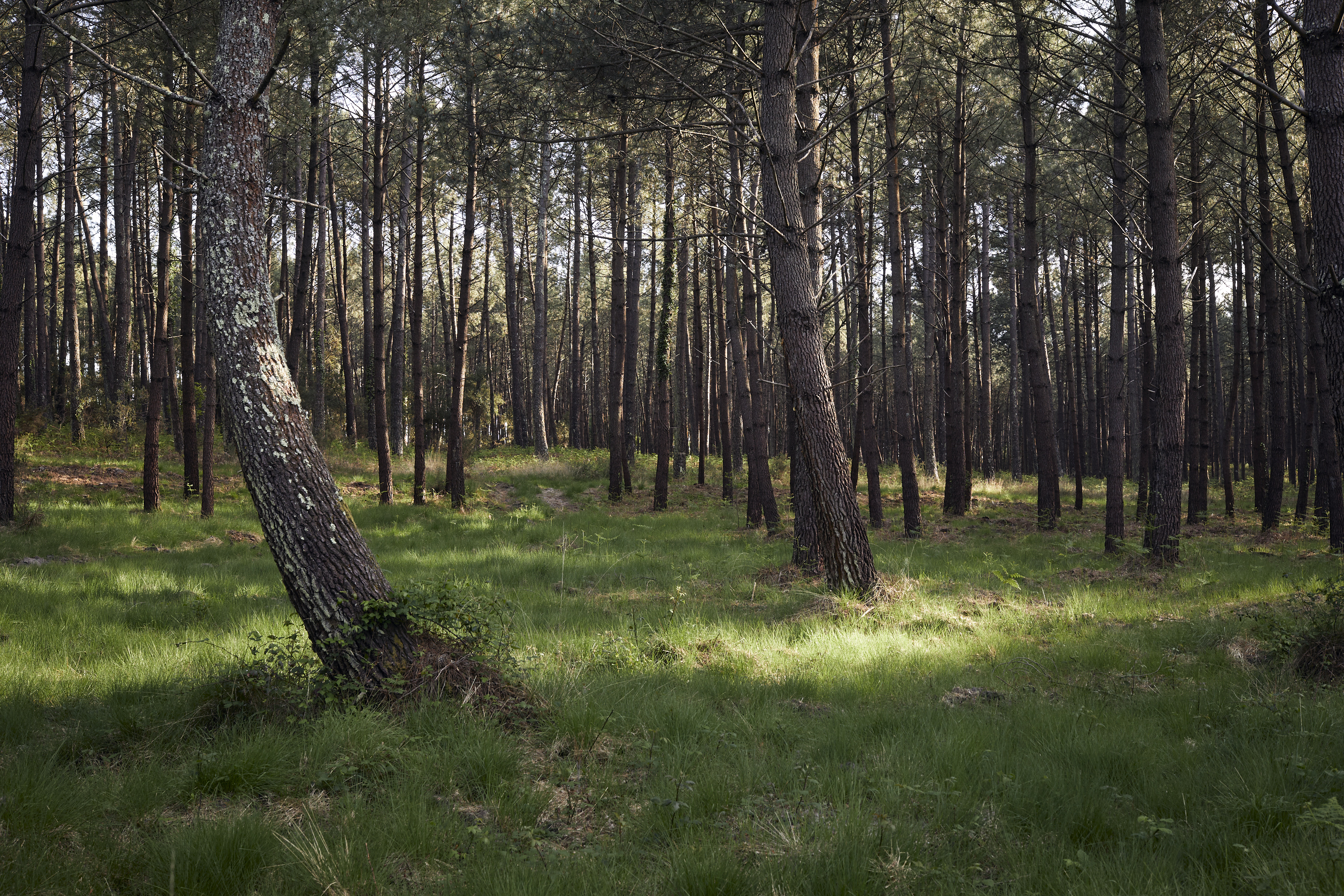
The trees were the first thing I noticed when we first arrived in Landes. Pines planted in straight rows seemingly ad infinitum mark a distinct boundary from surrounding regions. They are pleasing if slightly surreal. The size, the expanse of the forest makes it feel natural, as though it has always been there, encroached upon in certain places by human development, but still standing, still present. But one can’t help but notice that there is almost exclusively only one species of tree, that they are planted quite deliberately in straight lines, the underbrush cut away to reduce risk of fire. A number of individuals I spoke to and websites I visited referred to this landscape as sauvage or wild. What impressed me most about this characterization was that people applied it with the full knowledge that the terrain was a plantation, that it had been manufactured – in a sense – by turpentine producers.
As we first entered the region, driving along the departmental highway, I tried to convince myself that it was wild, that I did not see straight rows, or that that what I was seeing was not the overweening hand of human intervention, but a quirk, perhaps, of European nature, European forests, that I was simply unfamiliar with in North America. By this I do not mean to insinuate the superiority of Canadian or American wild space – as some kind of unbounded wilderness signifying unbounded promise; that too is a fiction. I live in a major city whose corona – an amalgam of suburbia, industrial land and suburbanized rural space – extends outwards for hundreds of kilometers. The province of British Columbia, where I grew up, has fifty-seven million hectares of forest, of which less than five percent is primeval forest; the rest has been harvested at one point or another. This means that an area approaching the entirety of France, is some form of tree plantation. The Landes forest is quite small by comparison. I simply mean that my unfamiliarity allowed for the opening of a kind of fantasy space. I am uncertain why I tried to do this as I looked out the window of the car, as I knew it to be untrue beforehand. In that moment, I wanted it to be fact. It was as though my mind was seeking through imagination to make it so.
It was the trees that made Hossegor possible, one of the rare instances where a spinoff of the development of heavy industry happened to make the region more appealing to tourists. Had the area remained a malarial marshland, fronted by mountains of sand pushed ever inland by the violent Atlantic winds, the area would have held less appeal to the developers and architects who first had the notion to build a beach resort town on the site.
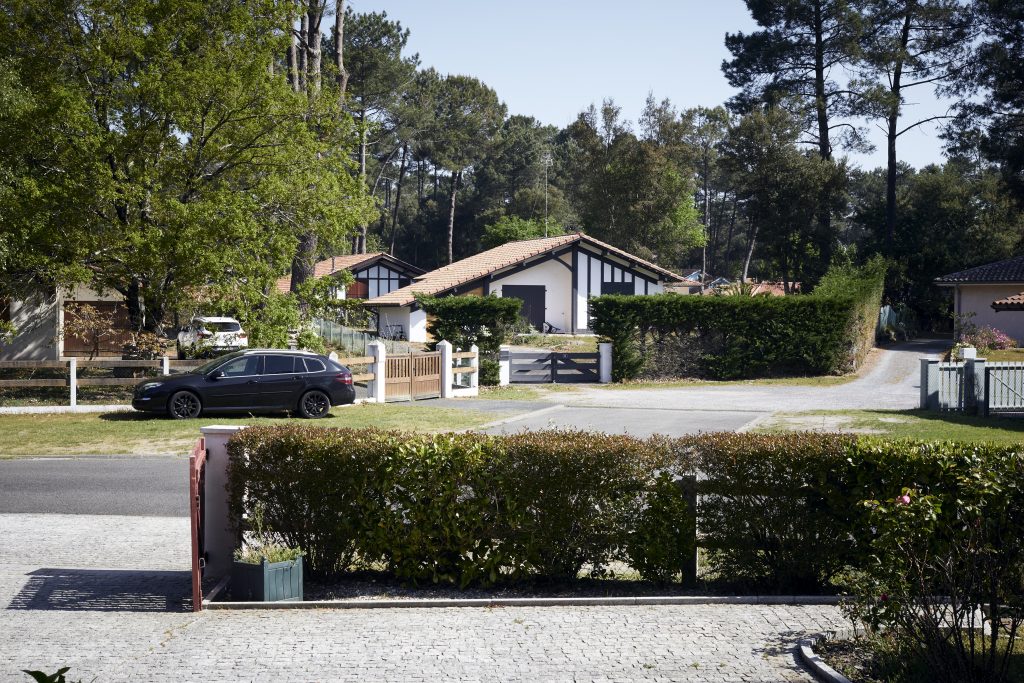
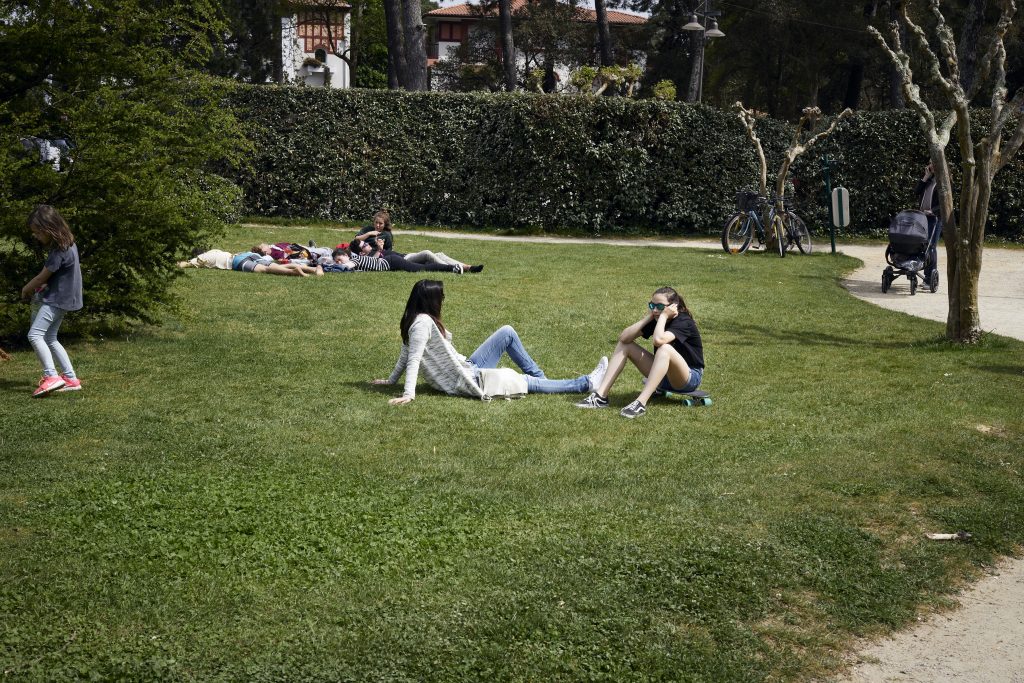
As I explored the region I discovered that there were four distinct areas – four distinct types of area, each of which provoked in me a particular psychic experience, each one almost a self-contained dimension, self-contained from nearby, even adjacent terrain. In my mind I named these the following: the habitations, the forest, the beach and the dunes.
The habitations are the built areas that weave spider webs through the tree farms. In effect they constitute one urbanized area, but are officially broken into a number of small villages: Hossegor, Capbreton, Seignosse, Seignosse Beach, and a small stripmall area called Pédebert, which was beside where we were staying.
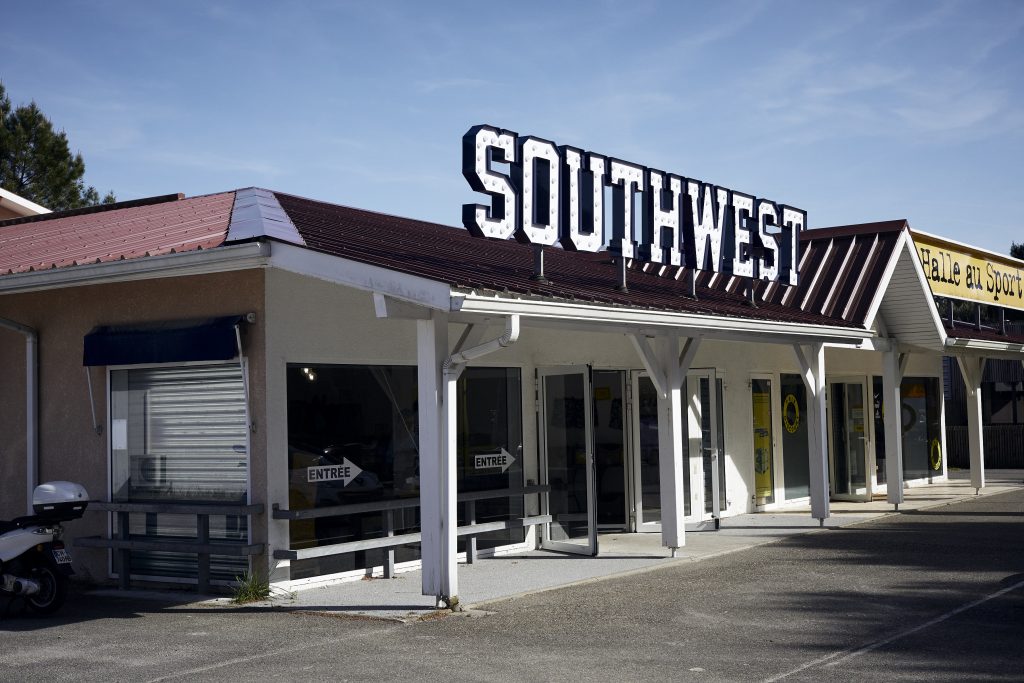
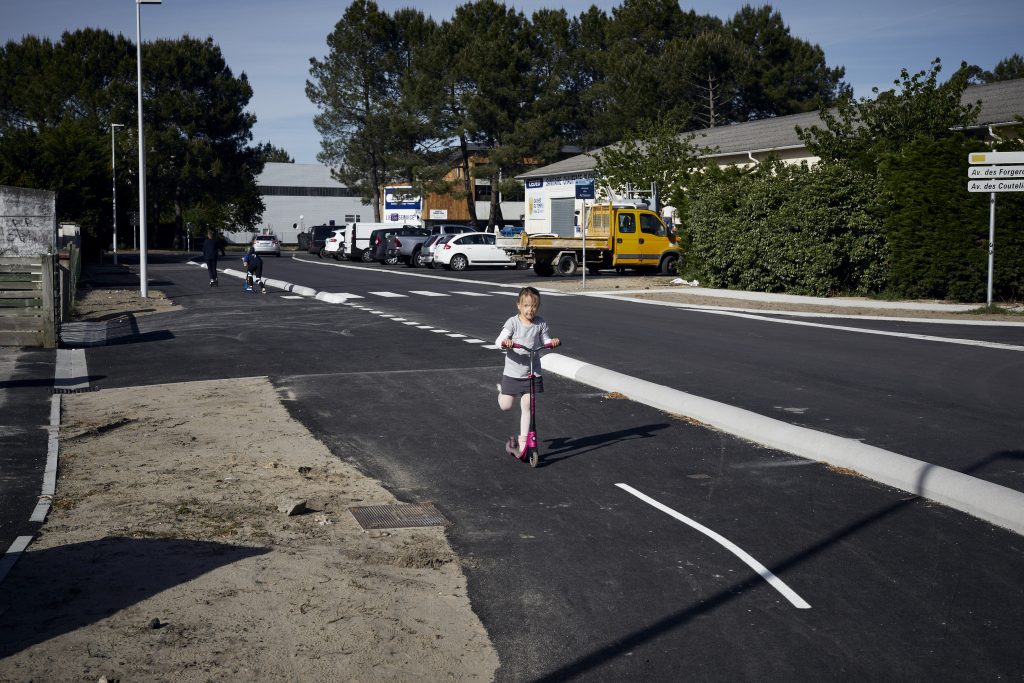
When we arrived there was a liquidation sale (called a braderie in French) going on amongst all the businesses in Pédebert. This is a once a year, multi-day event where everything in every store in the area is fifty percent off. There was a constant flow of traffic along the departmental road that passed the house, which my girlfriend’s father described as “infernal.” The event is known across the region and is especially popular with Spanish people who come from as far away as Galicia to shop for low priced brands. The businesses hire a team of people to manage cars and shoppers, renting large fields for parking, putting up caution tape and barriers along the side streets and the supermarket parking lot, even temporarily rendering streets one way to produce at least a modicum of order and fluidity in the inevitable traffic jam this event creates.
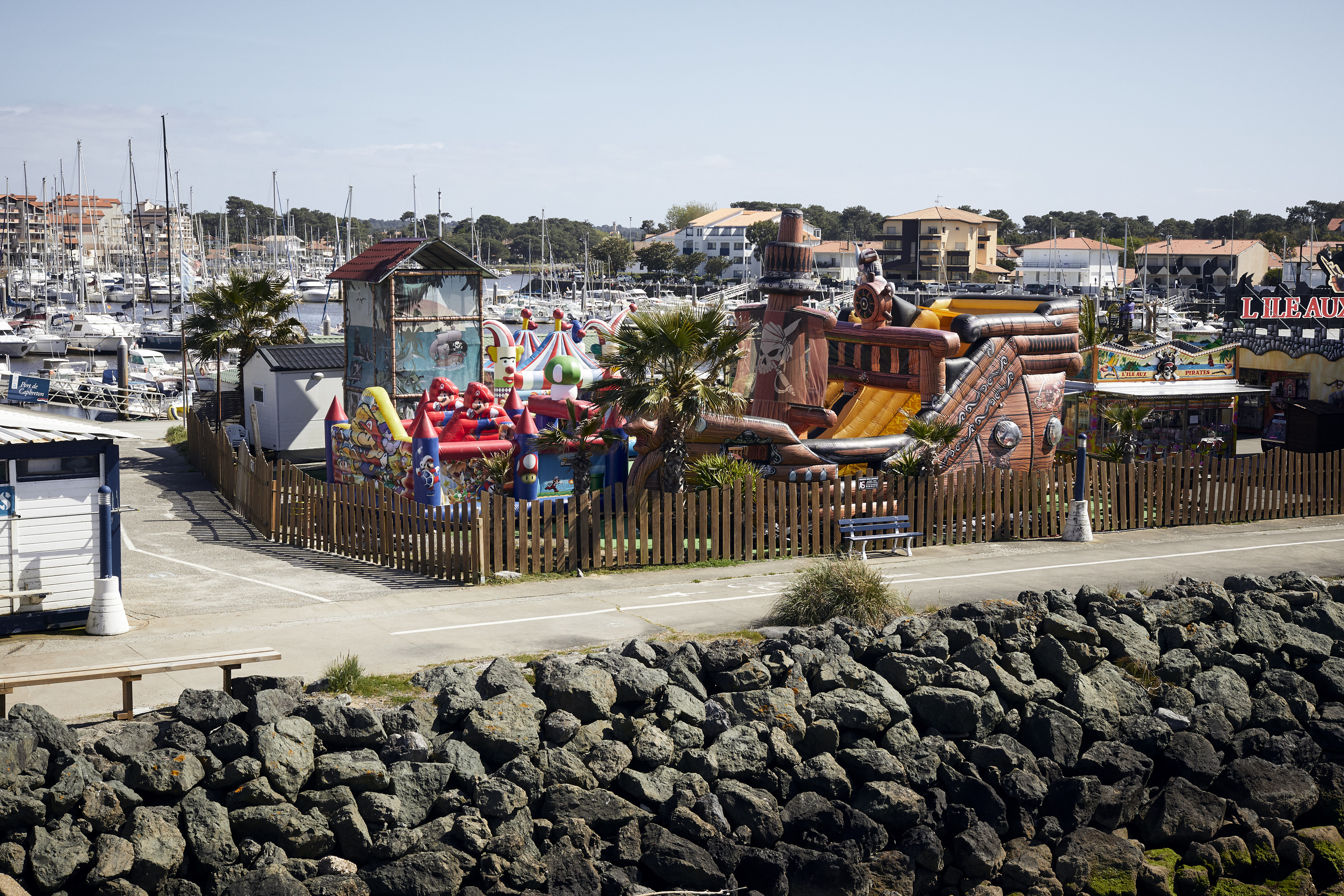
Capbreton is the only true port in the region. It dates to the Middle Ages. It is a fishing village (though now it harbours not only boats but also vacation properties). Under a special permission granted to them by Louis XIV, the fishermen here have the right to sell fish directly to customers, avoiding the typical intermediary process which is required elsewhere in France. On the beach slightly to the south, the ruins of World War Two-era German bunkers are slowly being reclaimed by the sea. Between the port and this southern stretch of beach, there is a line of concrete vacation houses and apartments which in design carry on the bunker theme. People fish in the channel leading to the port and there is a bustling, convivial popular feeling to the area.
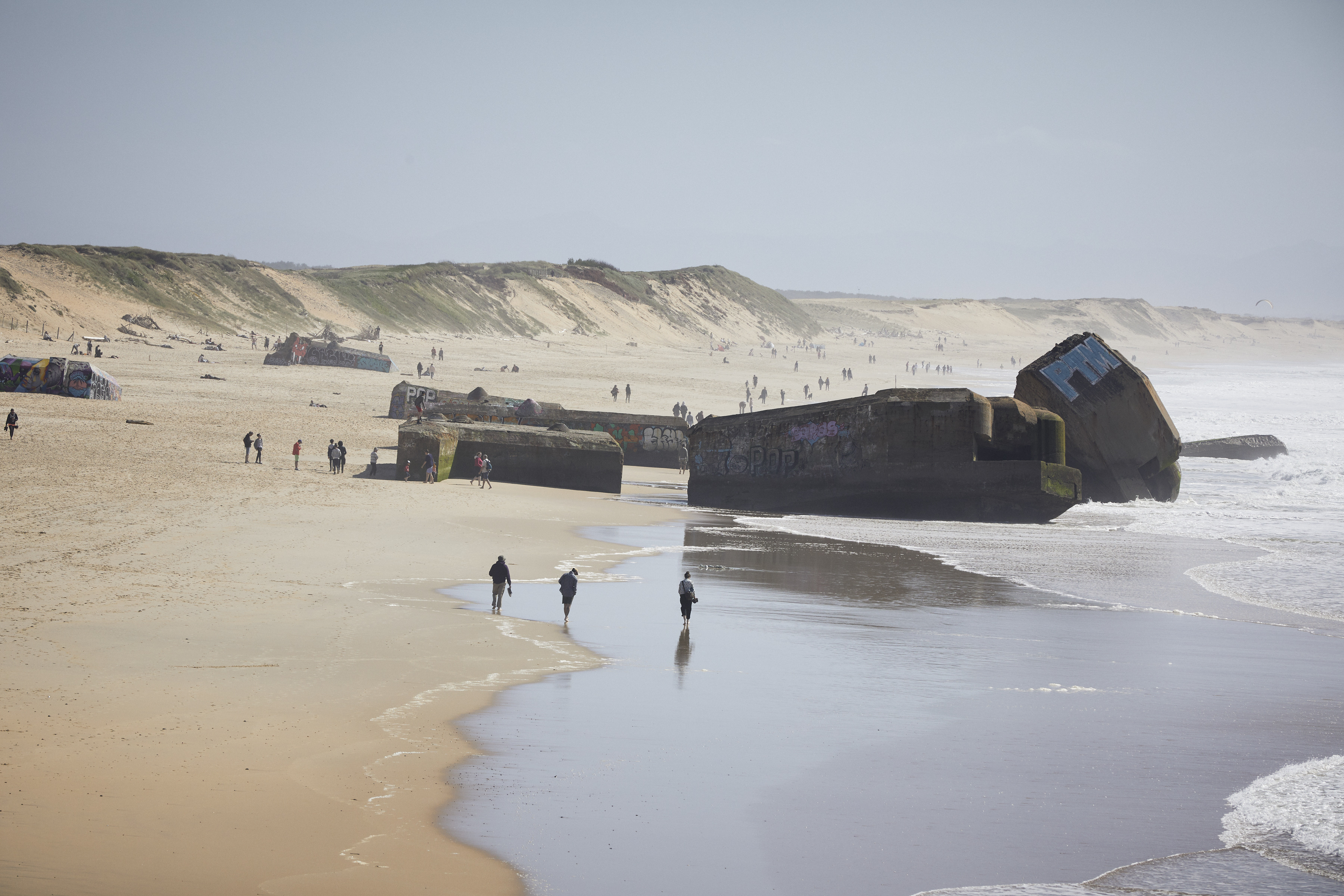
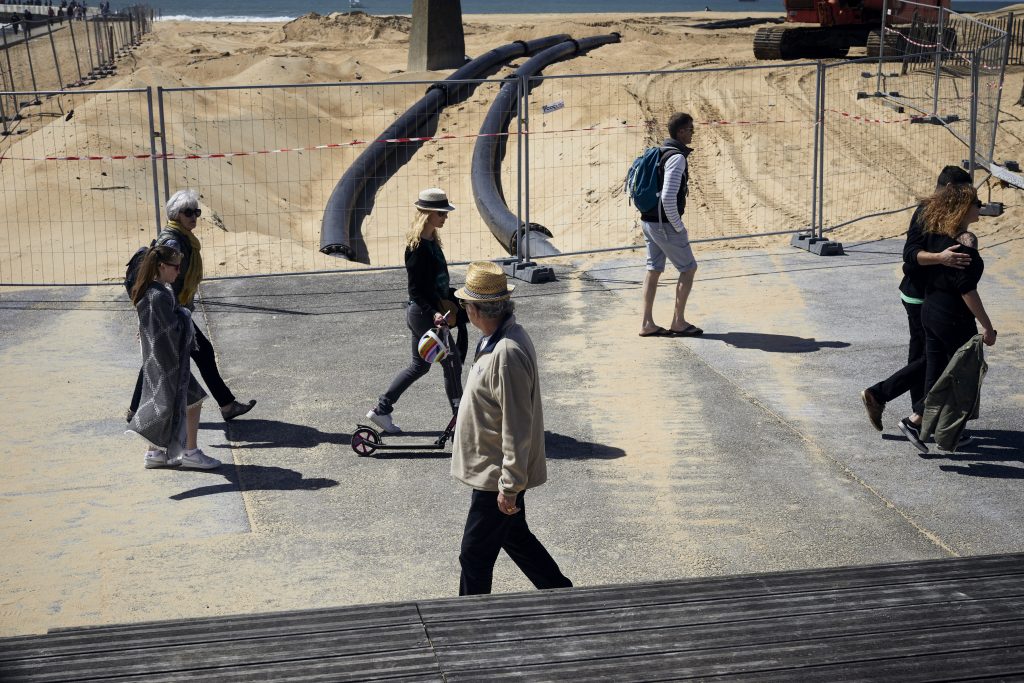
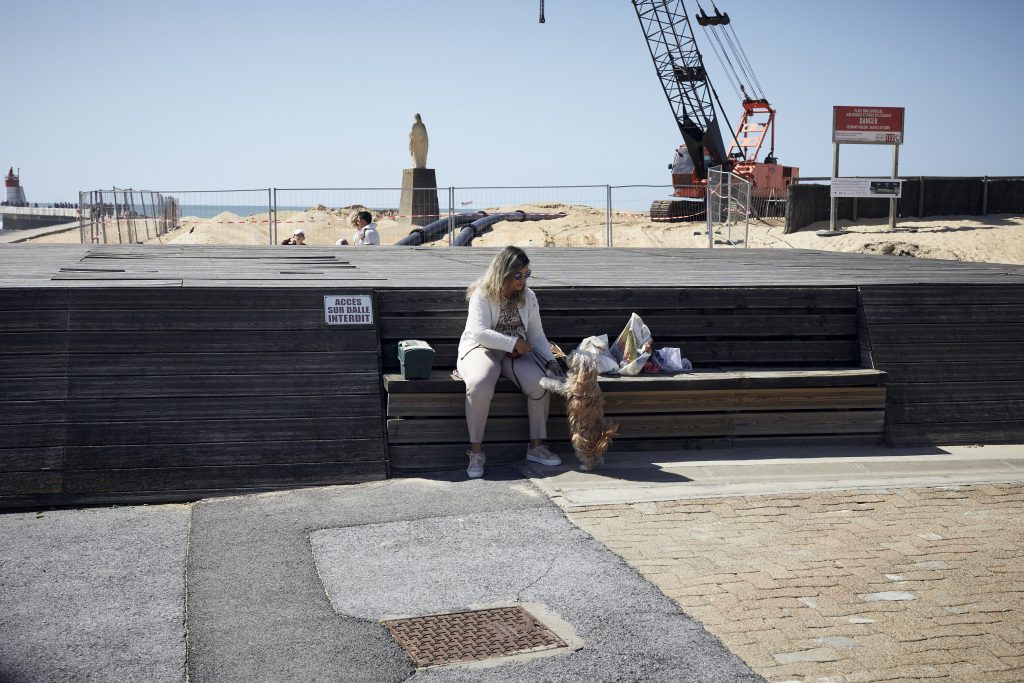
Hossegor, with its stately trees, elegant art nouveau and art deco homes, its golf course and salt-water lake is an attractive spot. Its beach offers world-famous surfing. The town itself exudes a sense of wealth, illustrated most visibly to me by a teenage boy walking with some friends wearing an ensemble of Balenciaga athleisure: hoodie, track pants and running shoes, an outfit, which after researching on the internet, I learned cost more than three thousand dollars. To the west of the golf course there is a short, one block street that stood out to me and puzzled me. It is named after Gabriele d’Annunzio, the decadent Italian poet and politician who is known as the father of fascism and gave the world, amongst other things, the gesture that would later come to be known as the Nazi salute.
The waterfront of Hossegor is quite built-up. The buildings are concrete and mainly yellowish. It is hard to determine their age. Some are obviously more recent, and some, despite the high cost of property and the prestige of the area as a vacation spot, have an almost Soviet quality to them: square and artlessly brutal, weather-stained and sea-corroded. In the main plaza on the promenade there is a restaurant named Rock Food, which at first glance almost looks out of business, though it isn’t.
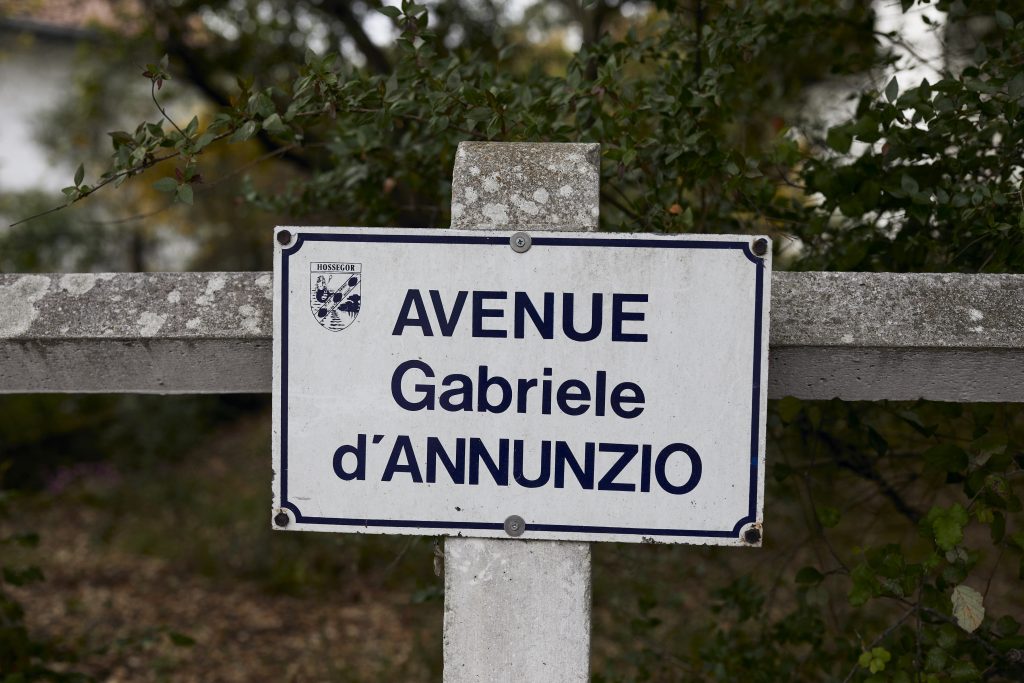
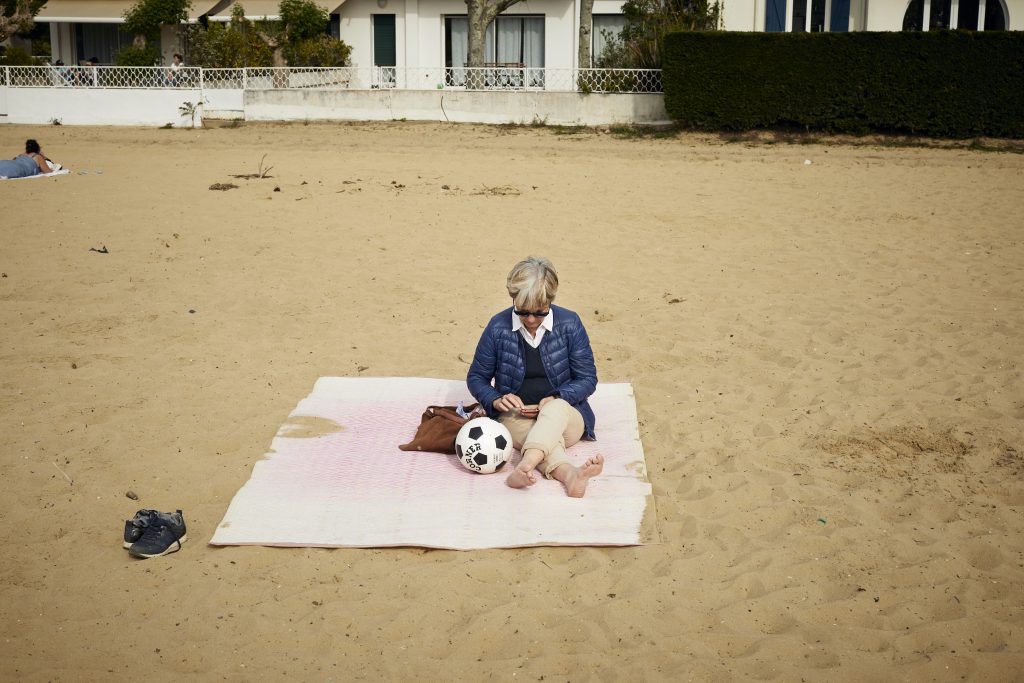
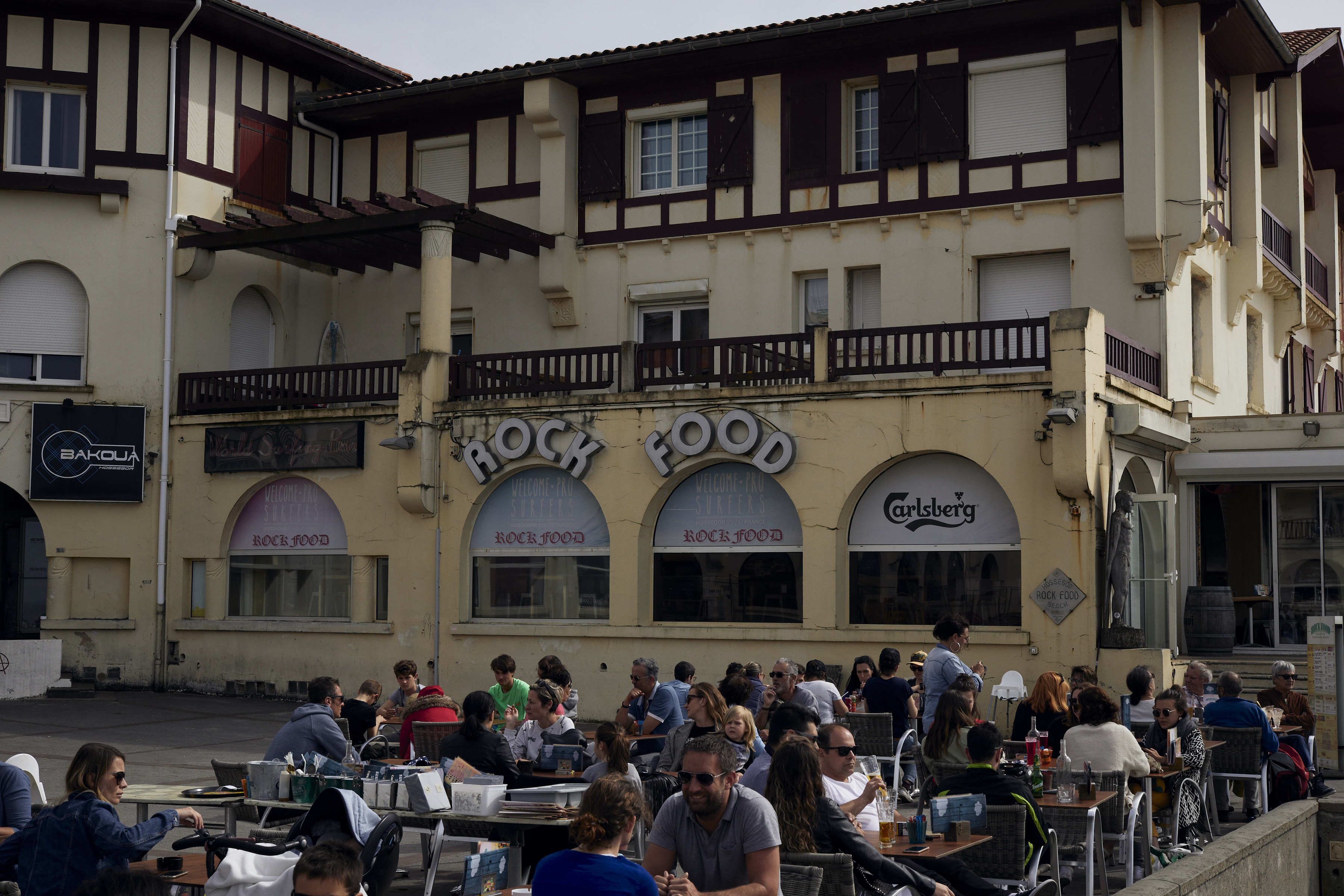
Seignosse is more inland, and generally more recent. It has developed in the last thirty years and has a more American feel: bungalow houses on cul-de-sacs with biggish garages on the side. At the center of the town there is an old church and a few old buildings surrounded by a number of pizza restaurants. Hossegor-Soorts, located further inland – the original Hossegor before it became a beach resort – is similar: an old church and town hall, surrounded by a pizza restaurant and other buildings.
Seignosse Beach is actually several beaches, which themselves are part of one long beach stretching up the coast almost to Bordeaux. Each one has a parking lot and a break in the dunes to get to the water, a self-cleaning toilet, a few restaurants, vacation rentals and places where one can rent surfboards and take surfing lessons. At one of the beaches there is a waterpark called Atlantic Park.
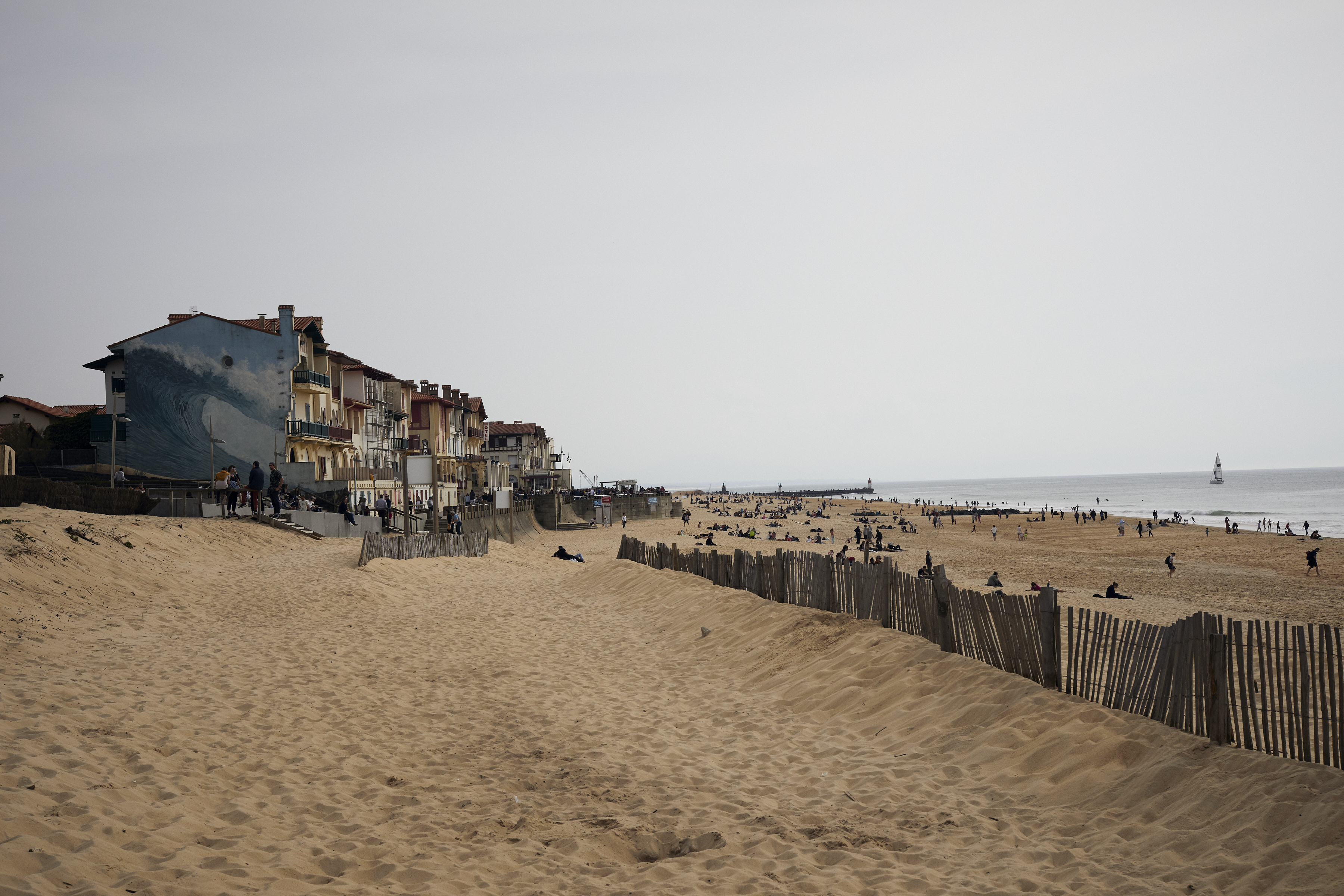
The Dunes
From the Atlantic Park waterslide complex, the dunes hide the view of the sea. The thought came to me that, protected by this barrier, the waterpark could exist in its own little world, could construct a vision of itself in which its waters reigned supreme, unchallenged by the devouring horizon of the ocean.
The self-cleaning toilets near the beach gave a sense of technology-driven efficiency and sanitation, but this was largely image. People had discovered how to hack their system. For instance, in one, somebody had defecated on the floor. After each new visitor the automated toilet went through its routine, thoroughly washing the bowl, but whatever process was meant to clean the floor simply misted on the pile of defecation, leaving a pool of fecal water expanding across the concrete surface, touching bare feet or splashing against the edges of sandals.
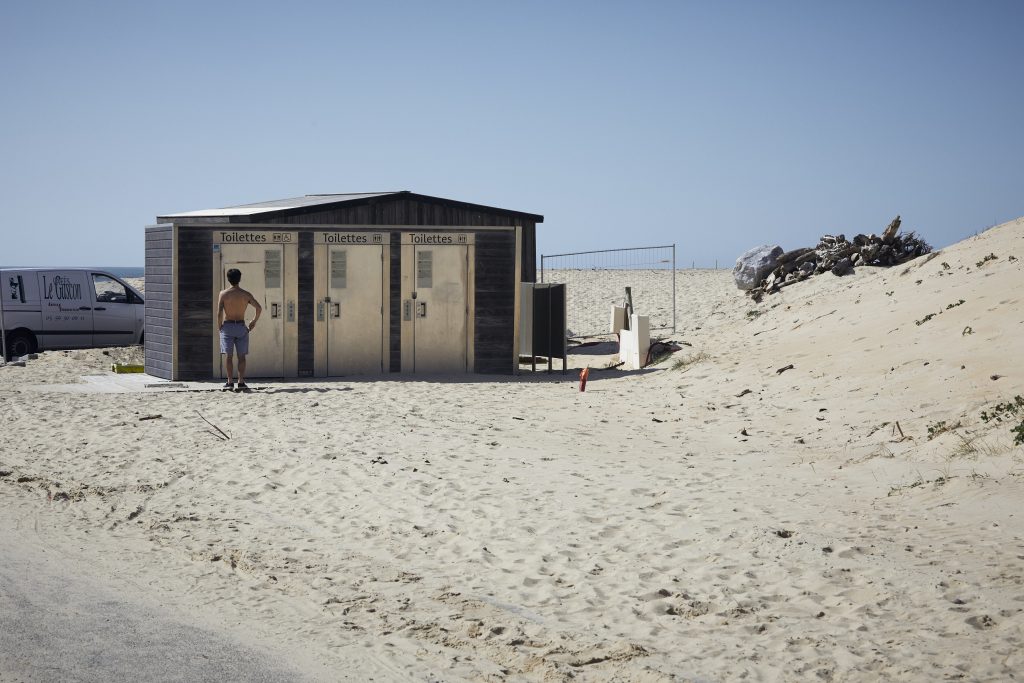
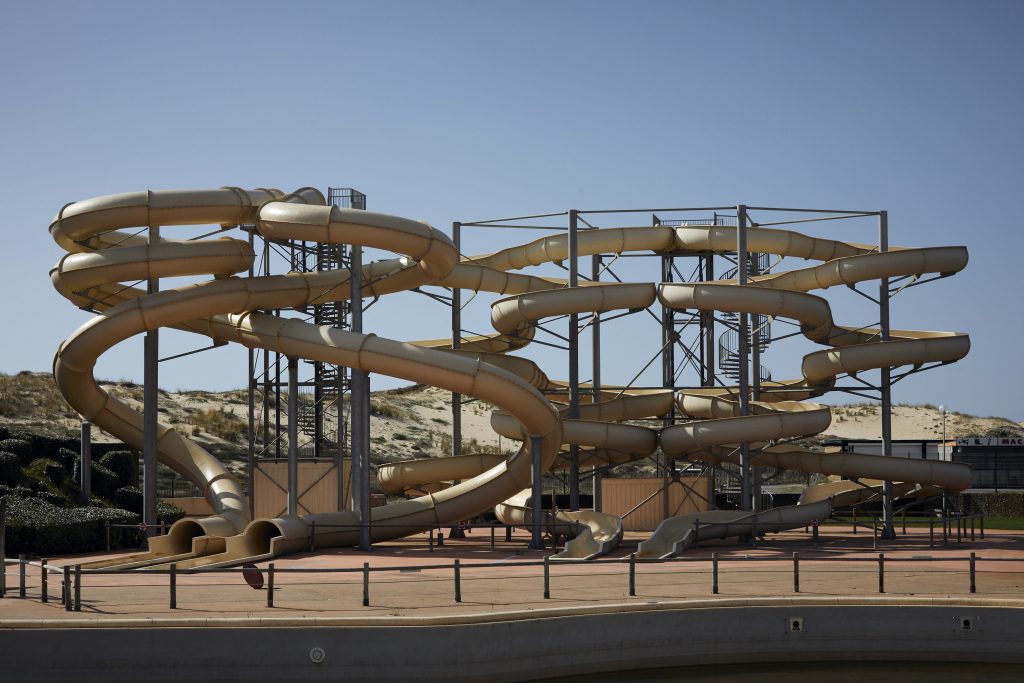
The dunes, running along the sea, dotted with grasses and succulents and fixed in place by the pines, as well as the Maginot Line of vacation properties, exude a rugged energy. They are a kind of wildspace that defies the boundary between nature and human engineering.
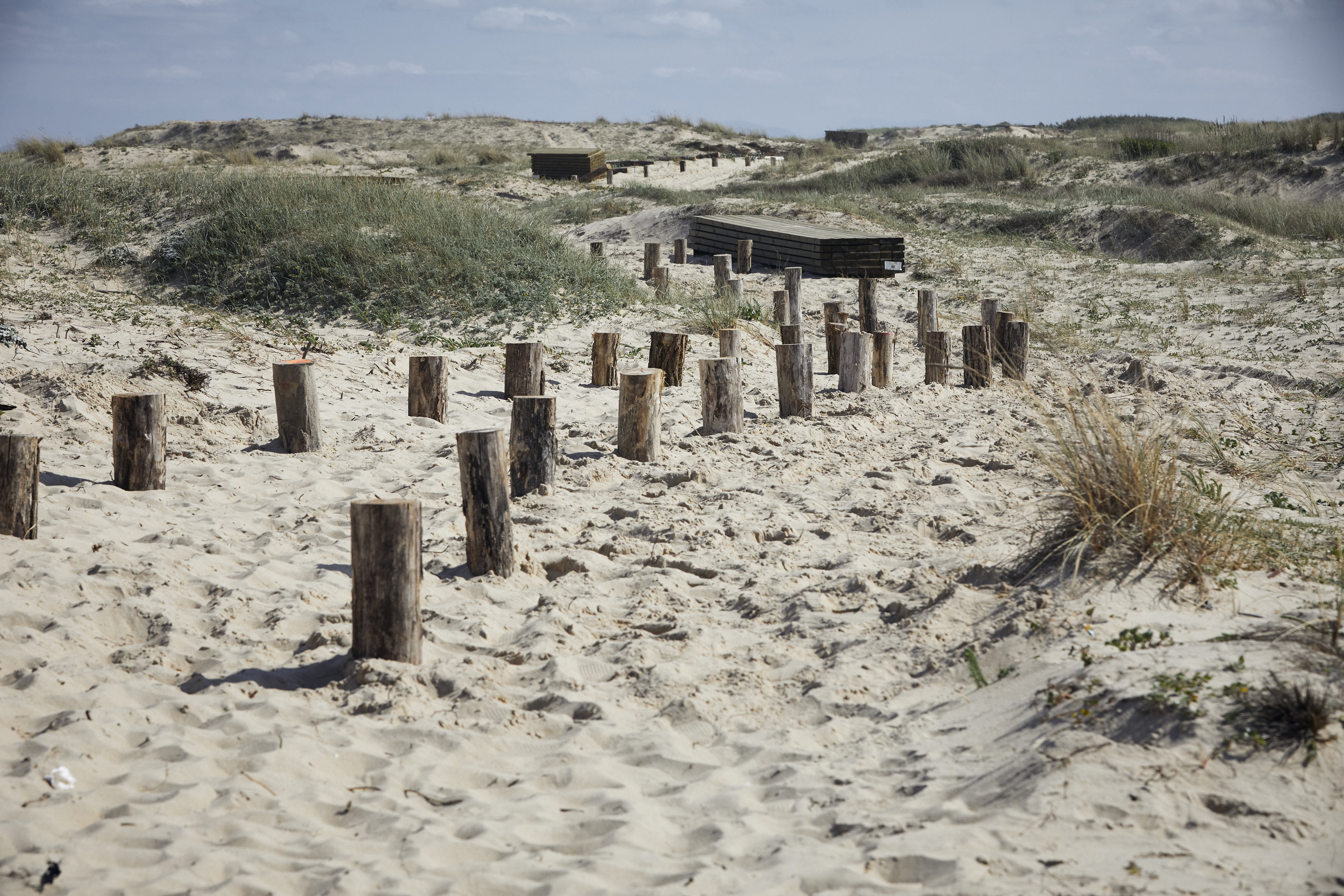
I visited Atlantic Park at the end of April, while it was still closed for the off-season. The town itself – if it is a town exactly – was also not yet up and running. Things were still largely shut down. A banner strung across a road advertised an event called “American Crazy Week.” This week took place over only two days: the 4th and 5th of May, and as to what it entailed I could only imagine. Some people walked dogs and others drank beer on the patio of a bar called Le Pas Sage (The Not Wise) located at the passage through the dunes to the beach. Others drank beer with dogs in the local square or whatever one wants to call it – a kind of concrete strip between the waterpark and vacation apartments.
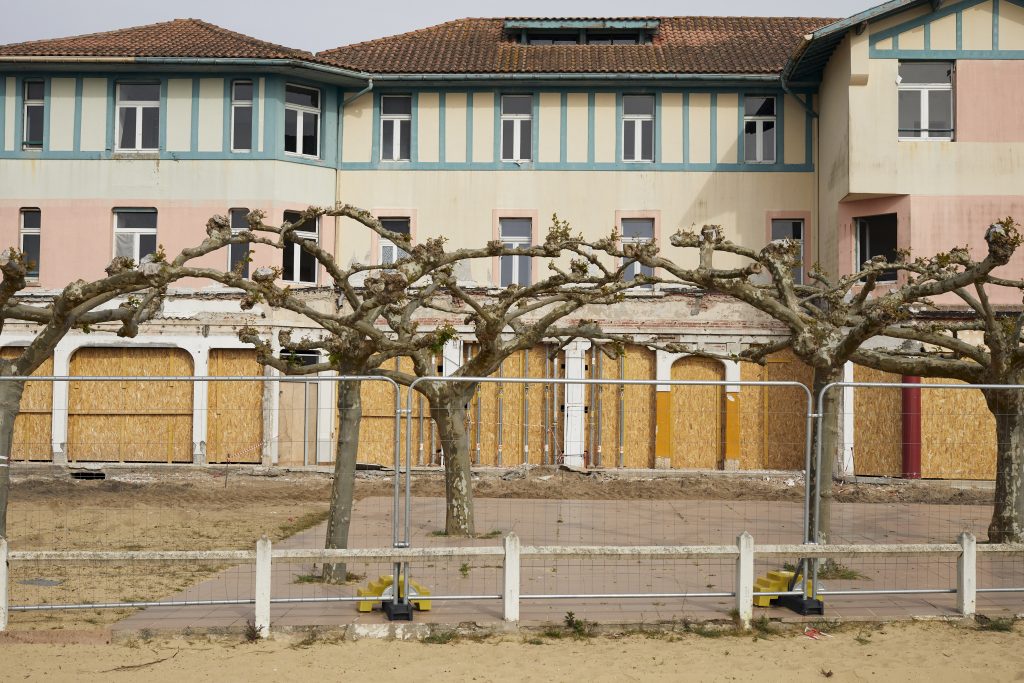
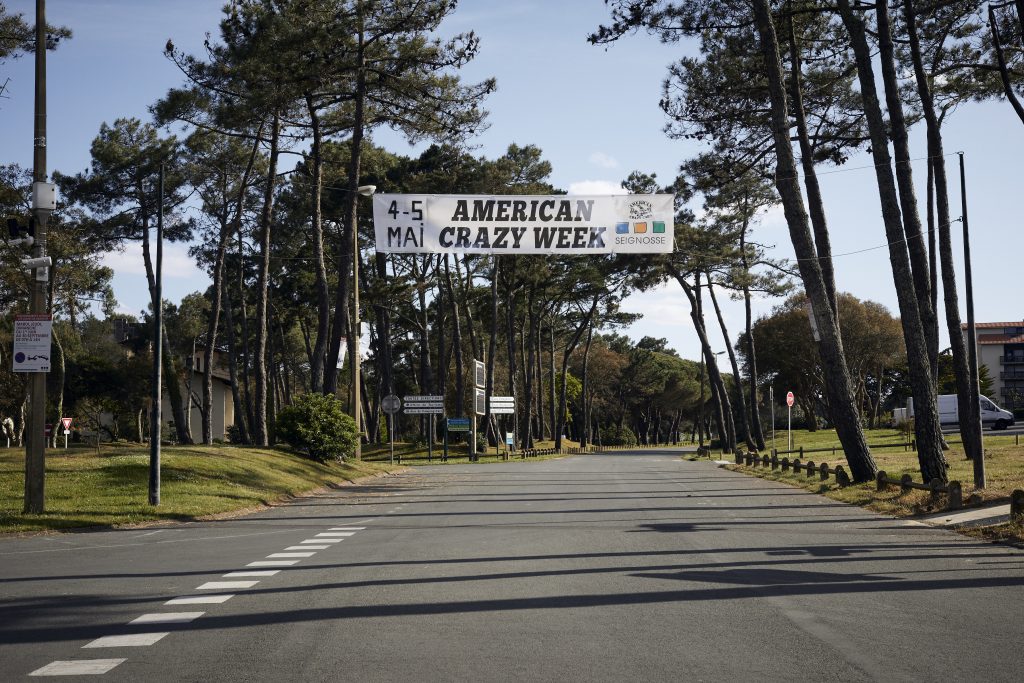
The sun was strong and I felt dry, somewhat thirsty. My interest was to photograph the shuttered waterslides. Lacking clients, their tubular forms resembled some kind of industrial apparatus, like a refinery or chemical works.
Looking through the metal bars and seeing the grounds, decorated with palm trees and manufactured rocks, reminded me momentarily of what pleasure these types of nakedly artificial, engineered landscapes engendered in my friends and I as children. I wanted to go up on the dunes to get a better vantage point. As I walked through the asphalt passage that leads to the shore there was an old woman standing by a blown over section of fencing. She was overdressed and staring silently at the sea.
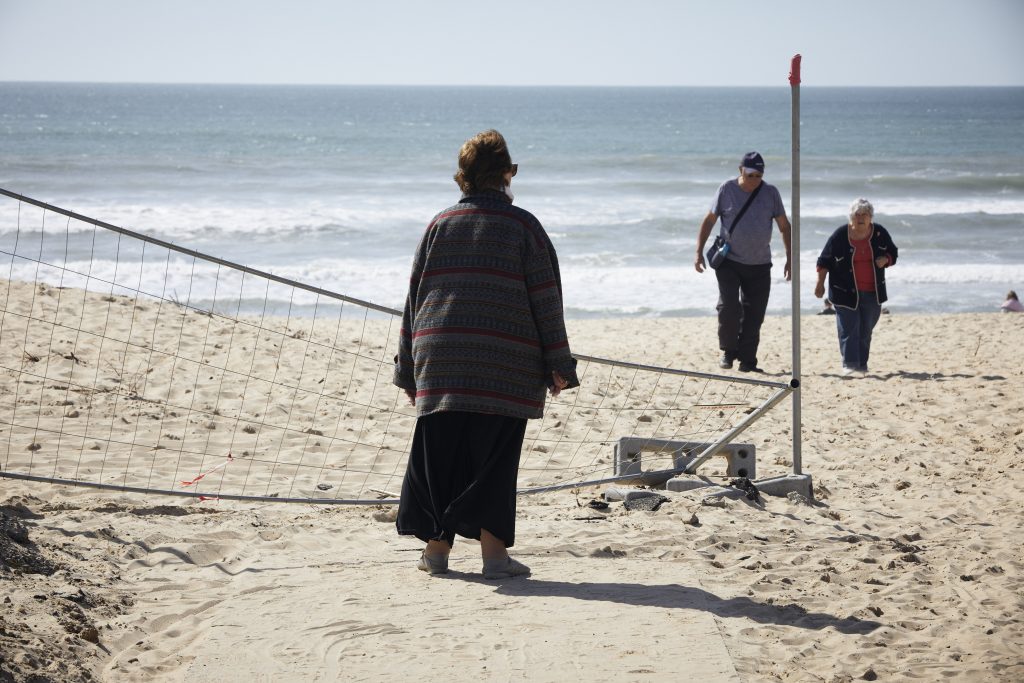
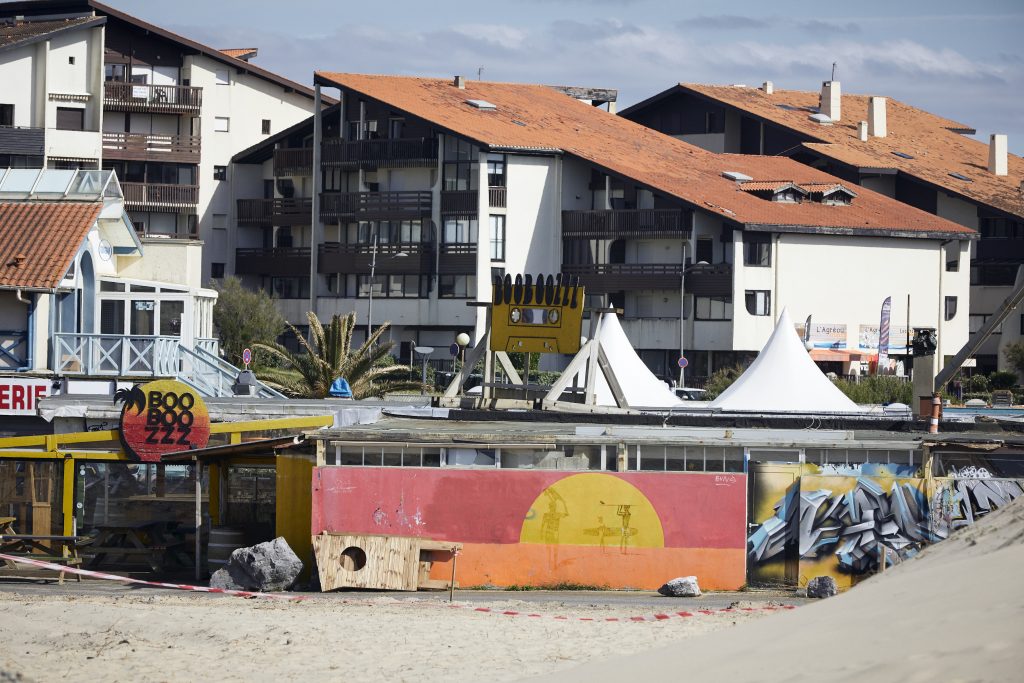
A number of paths crisscross the sands between the scrub plants. I passed one man sitting, looking out, but then there was no one. At one point there are a series of posts driven into the ground suggesting a road almost. The breeze was fresh. The dune towers above the village and the sea, as well as the water slides. It is enormous. I could see far out to sea, the mountains in the distance, a ship that looked like a drillship had been anchored off the coast of Bayonne for at least the previous week. On the other side of the dune I looked down on the waterslides and the tiny people walking along the plaza.
After photographing for a few minutes I felt a strange discomfort. I looked up to see a man watching me in the distance. He had a shaved head and was wearing a white tank top. I tried not to make it seem as though I had just noticed him, but he stood there watching, not moving. At first I felt conspicuous, with my white, telephoto lens, on top of the dune, but as I looked around I wished I could be more conspicuous as I noticed that there was no one around. In fact the dunes concealed much more than they exposed. If one stepped back just slightly from the edge, people down below saw nothing, heard nothing, especially with the wind and the crashing surf. As a space it was strangely isolated, cut off from the heavily frequented beach and village, which in linear distance were not far off at all. It felt like a different kind of space altogether, a ribbon of solitary desert cutting through the center of holiday cheer. The man stood in the distance still watching. My heart beat somewhat faster and I sweat. The sun made me slightly dizzy. If I hadn’t been carrying so much expensive camera gear I would have felt differently about everything, but an image came to my mind of how easy it would be to be robbed up there and then have the robber disappear into the dunes before I had time to find my way out. This was likely untrue, or maybe it wasn’t – slide out the edges and disappear into the pines. I have no idea, of course, what the man watching me was thinking, but I was affected by the implied threat of surveillance, the latent malevolence of the mysterious observer. It wasn’t lost on me that only moments earlier, that had been my role. Convincing myself that I was unsatisfied anyway with the angle, I hurried off towards the asphalt passage leading back to the settlement. As I walked, I was now more aware than before of the instability of sand and how it slowed my movements, but I took comfort in the thought that they would slow the watcher’s steps as well, who at any rate was not following me and had disappeared from view.
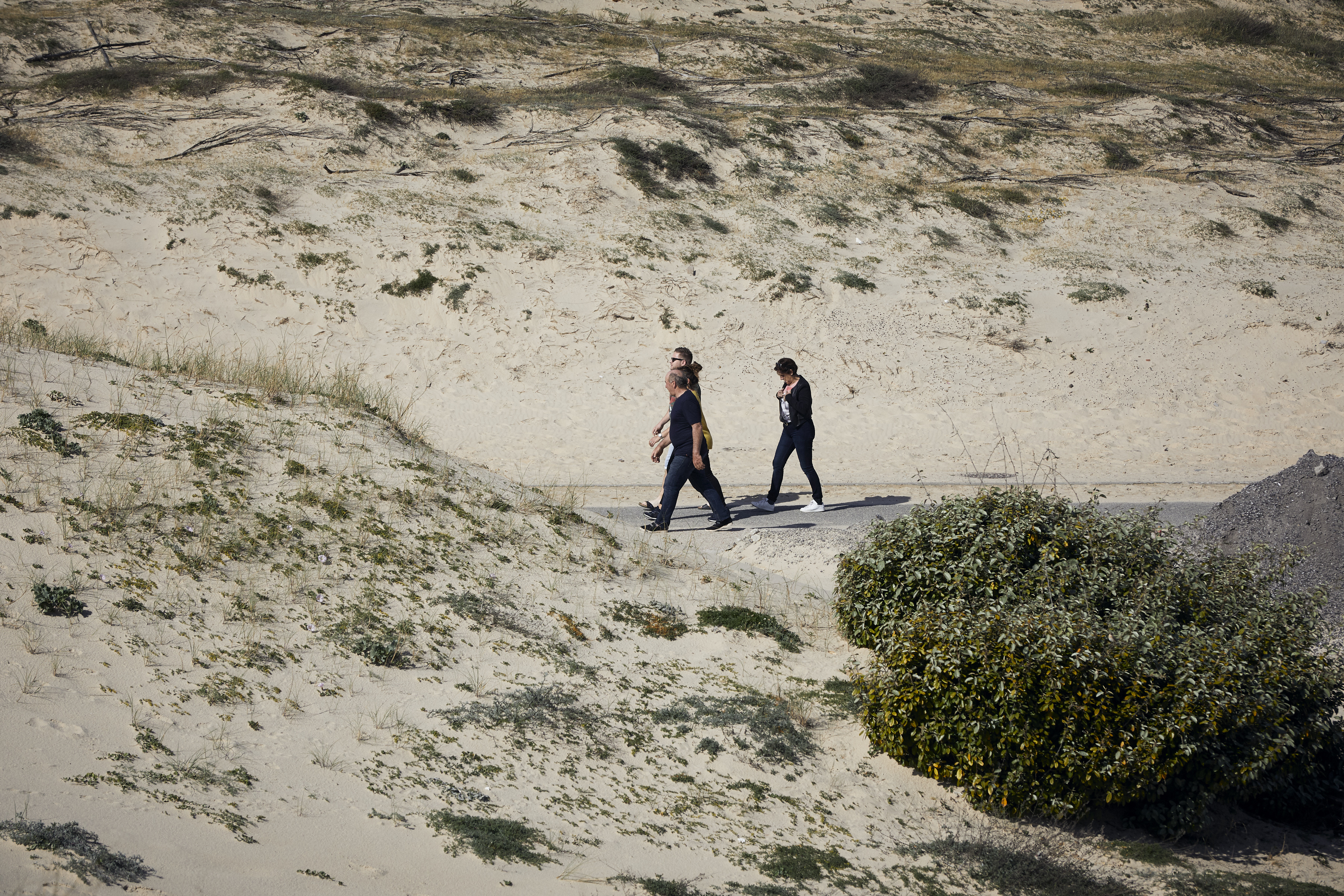
When I made my way back down the dune, the older woman who had been staring out to sea had returned closer to Le Pas Sage and was talking with some of the dog walkers. She was explaining to them how she had recently been forced to move eight times, but then said it was good to be living by the sea because the salt air “clears the nasal passages.”
As I walked around I couldn’t help but feel a little uneasy. I don’t know why exactly. It was as if the discomfort I had felt at being watched had been passed from the man to the land itself, that the region had taken on a temporary taint of unease.
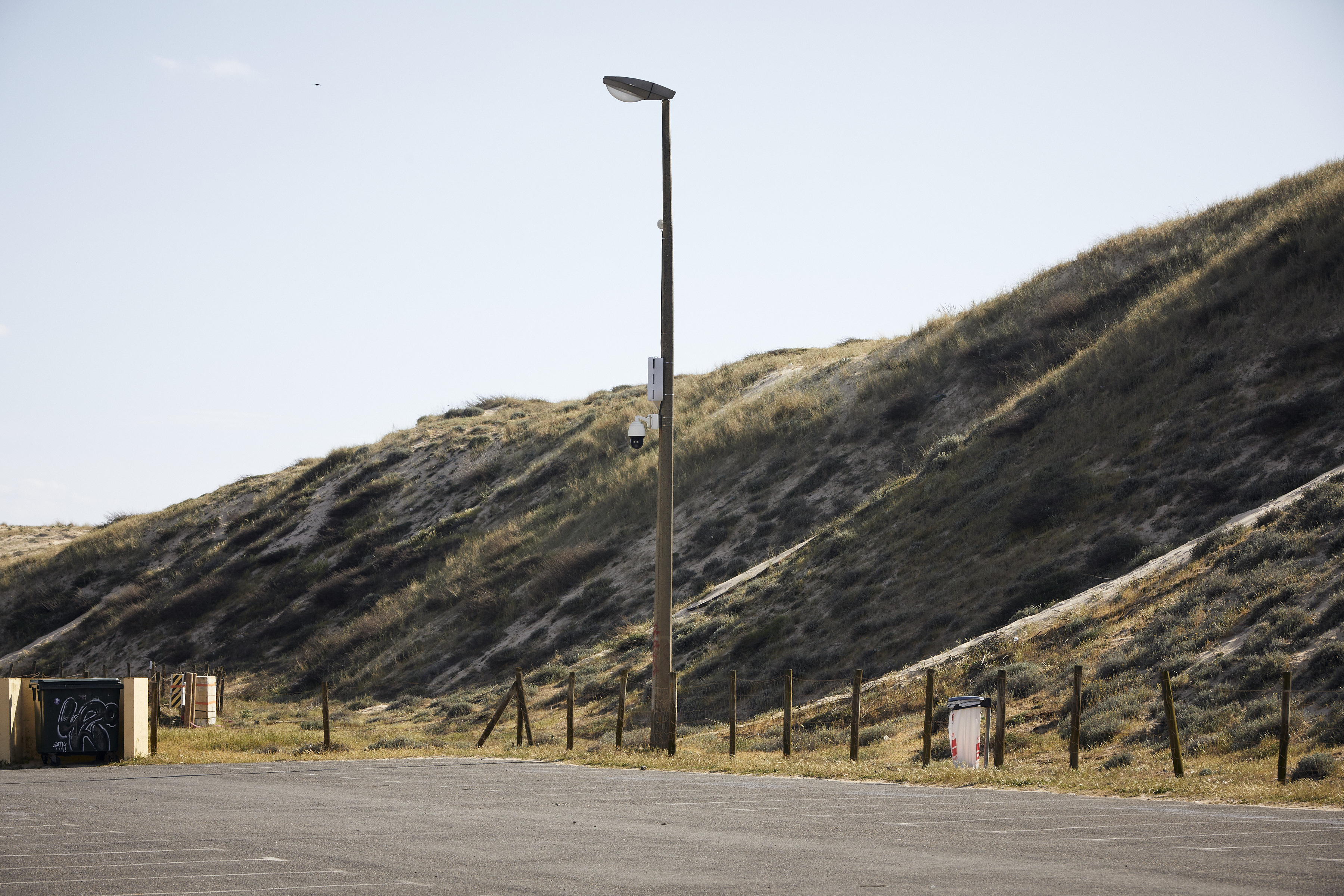
Everyone United Against Expensive Life
We did much of our shopping at the Intermarché, which is the large supermarket in the Pédebert area. Generally speaking, it is very American in its design: a large box fronted by an expansive parking area. Inside, it also much resembled a North American supermarket, with many products, broad aisles and so forth.
On one occasion as we were trying to enter, I was stopped by the concierge at the customer service desk. She informed me that I would not be able to access the store with my backpack – a precaution against shoplifting. I was uneasy with the idea of leaving my bag with her, however, as it contained all of my photographic equipment. My partner and I agreed that I would wait in the entrance while she procured the things we needed for that night’s dinner.
I milled about in the front. There was a glass window built into the floor, that allowed one to peer down into the wine cellar. This was where the expensive vintages were protected. The window looked down into a bright, white space, where the wine bottles were neatly arranged and displayed in such a way that they were visible, but I couldn’t quite make out the writing on the labels. I spent some time entertaining myself by trying and failing to read the dates and names written on them. The enclosure was accessible by a kind of robotic door, like an airlock, that an employee opened with a special key, and contributed to the general aura of spaceship conjured by the wine cave.
Presently I felt tired, however: the effects of the purportedly non-drowsy allergy medication I was taking. Slightly dizzy, I sat down on a bench near the automatic doors. In front of me was a display, which I stared at, finding the whole thing somewhat puzzling. The display featured two low-cost bicycles which had been branded as Interbikes. This part in and of itself was not particularly unusual; what I found more inscrutable was the banner hanging on the wall behind it. It read: “Tous Unis Contre La Vie Chère,” or Everyone United Against Expensive Life. It may have been the medication, but I stared absently for quite some time at this slogan. I was almost impressed with the kind of marketing emptiness it seemed to project. It managed to invoke a sense of unified political engagement, especially as it seemed to recall one of the talking points of the Gilets Jaunes protest movement (still ongoing at the time) which was a collective anger at the erosion of purchasing power and increasing poverty across the country, while managing at the same time to elide, and in fact erase the issue altogether, replacing complex political meanings with a bland and cheery exhortation to save. If I found the text of this banner strange, I found the imagery stranger still. It surely did not depict unrest or upheaval of any kind. Instead it showed a white, middle-aged couple in matching active-wear outfits, riding down a mountain slope in Africa. To say that it was in Africa is maybe not exactly even correct as it was an impossible Photoshop construct of sorts – more a map than a photograph even, but signifying what exactly? The riders seemed to be coasting down a slope, which I have to locate in South Africa, because spreading out in front of them was the entire African continent, as well as all of Europe and the Arabian Peninsula. Given the perspective, this mountain must have pierced the atmosphere, rising into the territory of low-earth orbit. It was the vantage point of a satellite, and yet these cyclists had no need for oxygen or protective suits.
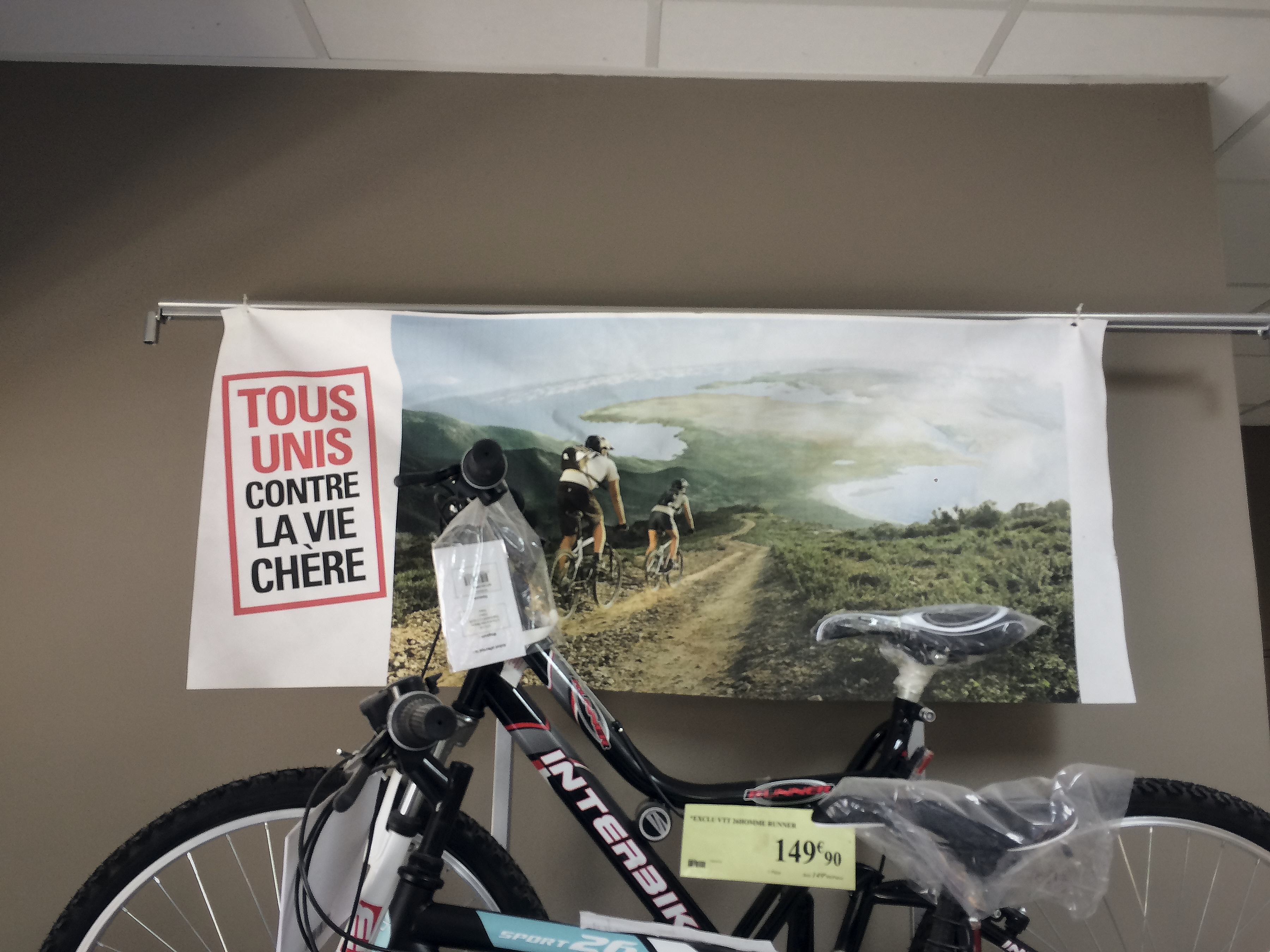
My mind struggled to apply some kind of political meaning to this installation, but clarity escaped me. Instead my thoughts wandered to imagining the creative meetings – the conversations between artistic directors, copy-writers, photographers, illustrators and managers that must have come together to produce this banner – the layers of administrative process that are inherent to advertising – and how it all came together to create this object before me. I closed my eyes, feeling the light warm tingling that Reactine generates in my fingertips. Opening them, I saw that my partner was now bagging grocery items at the checkout. I went over to aid her. We carried the bags to the car, went home and made dinner.
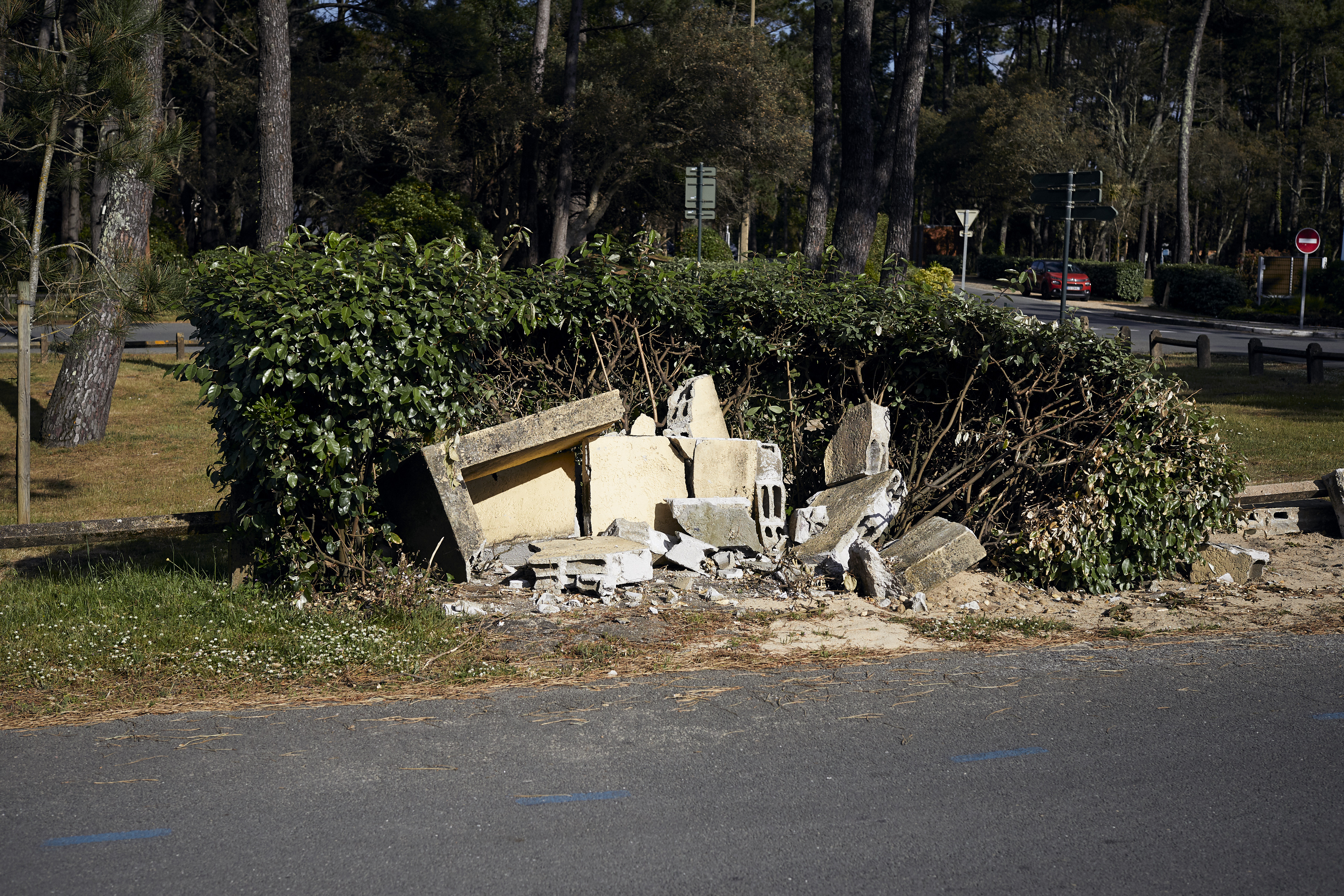
The Pines
Like the dunes, the pines are a distinct environment, a kind of space utterly unto itself. They are surrounded and cut through with roads and habitations, but to be in them feels utterly unlike being anywhere else, even when one has only entered a few hundred feet inside their boundary. In the morning it had rained, a light drizzling rain. By the afternoon the clouds were breaking apart and the sun came out, though it was one of those unsettled times when the day is peppered by moments which are both hot and cool.
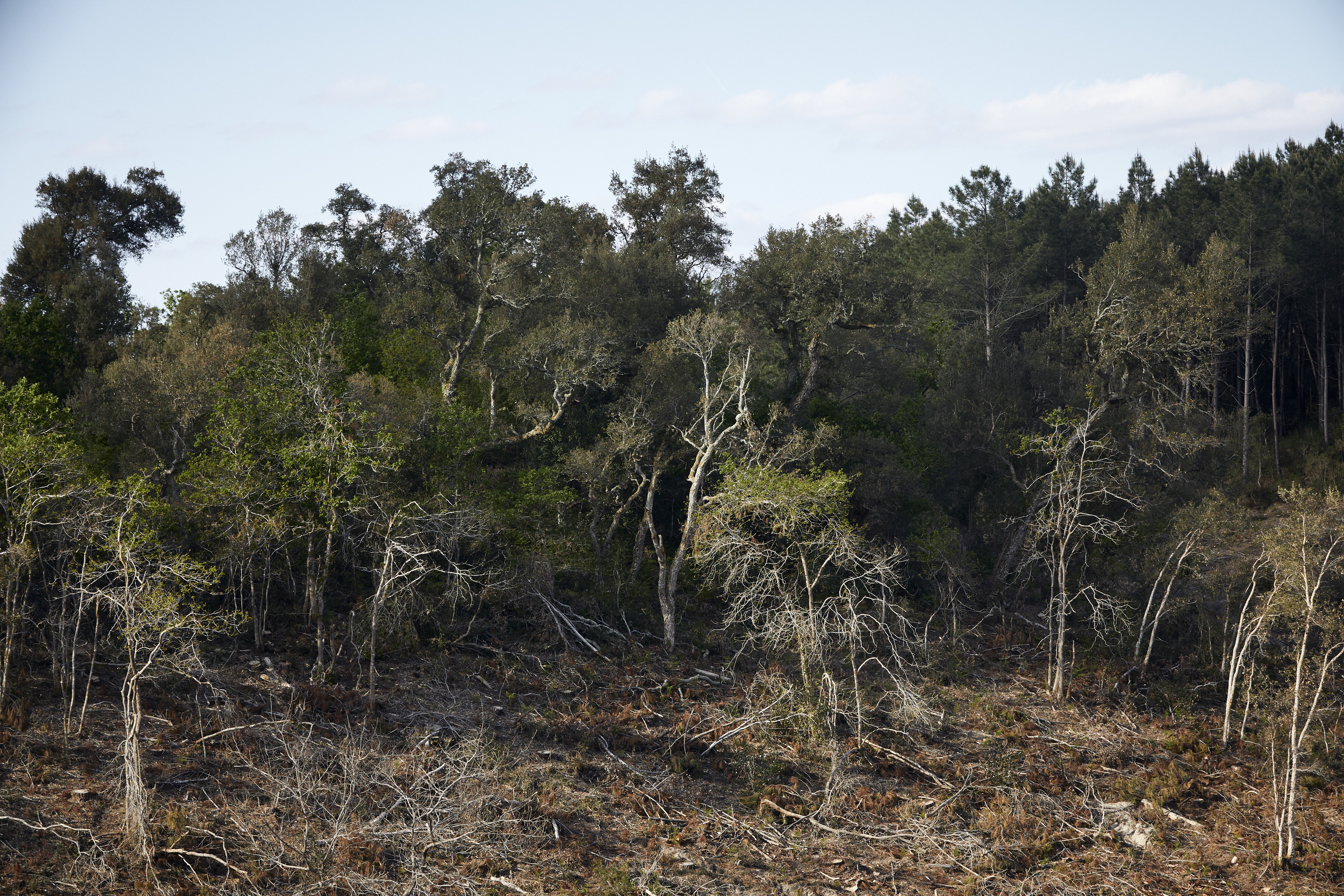
At the end of the street where we were staying there was a path that led into the trees. Perhaps it went to the beach; we were uncertain. I took this path that afternoon, when the sun began to come out. The path was sandy and in many places there were large puddles. Tree pollen formed iridescent patterns floating on the surface.
Once inside this area, there were no more houses. These are tree farms and building is not permitted. A variance must be granted from, I don’t know who, the department maybe, in order to construct buildings. That is what happened in Seignosse, Hossegor, Pédebert. Any surrounding noise was absorbed by the trees so that the noises I heard were the noises of a forest – birds and wind, but mostly wind, because bird populations have plummeted across Europe in recent years.
Once inside the trees I had the feeling that they could have gone on forever. I had no sense of geography or space. There were no people. In certain areas, all of the pines had been cut, exposing sand and brambles, and the odd cork or other species of oak tree that remained standing, which the companies seemed not to have the right to take. I imagined that possibly in the future, with the cutting of the pines and the leaving of the oaks, this might transform into an entirely different kind of forest, that the oaks might slowly take over and by a hiccup of regulation transform these forests into ones that no one any longer had the right to harvest. Probably not.
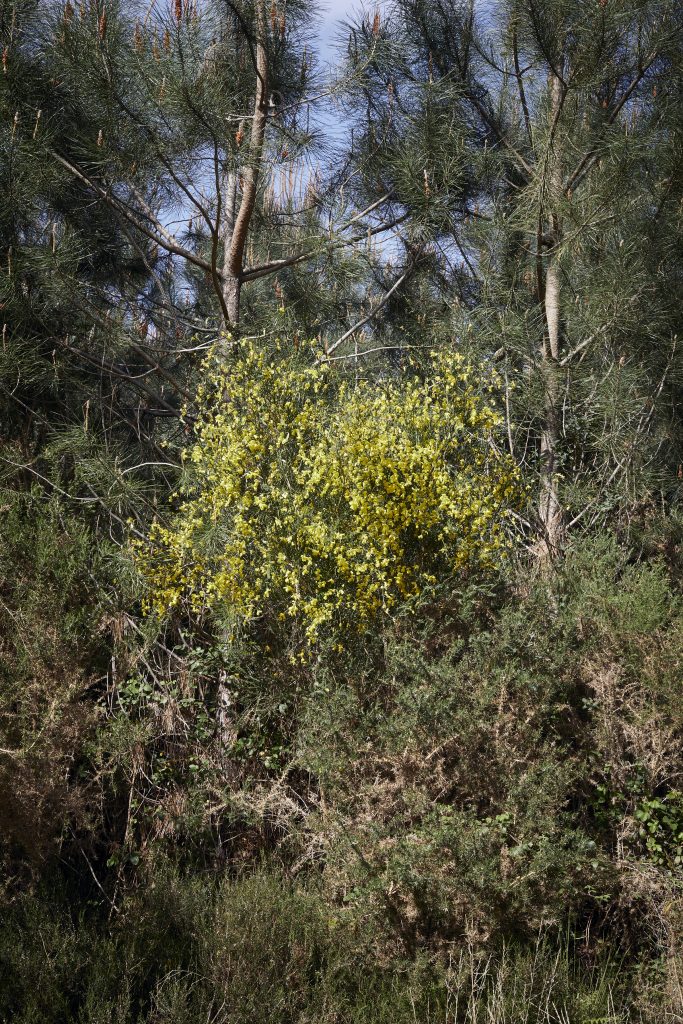

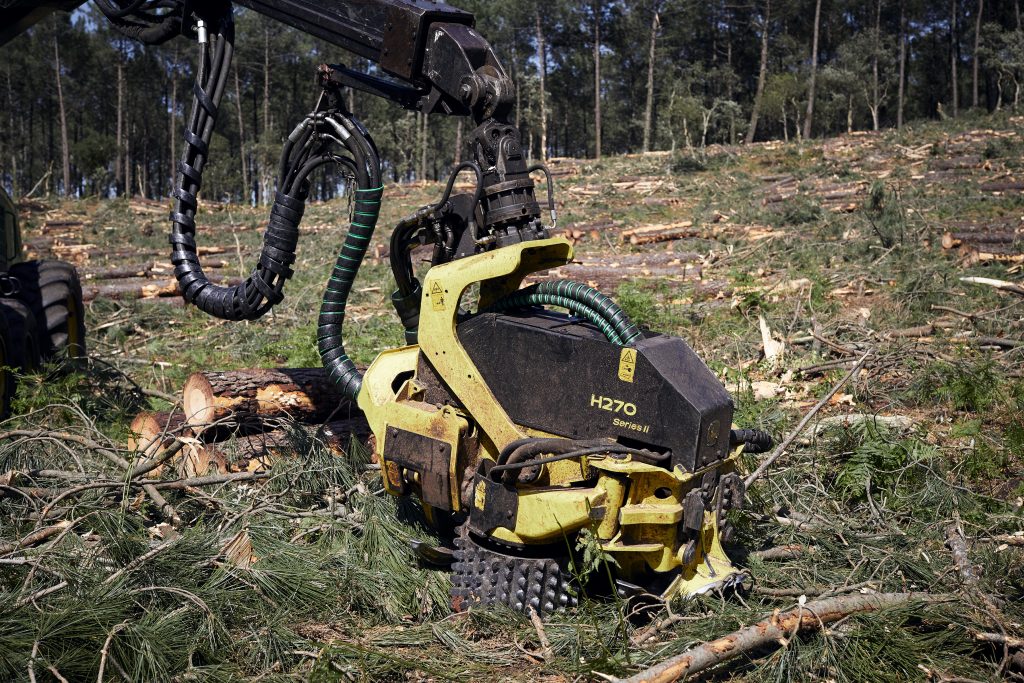
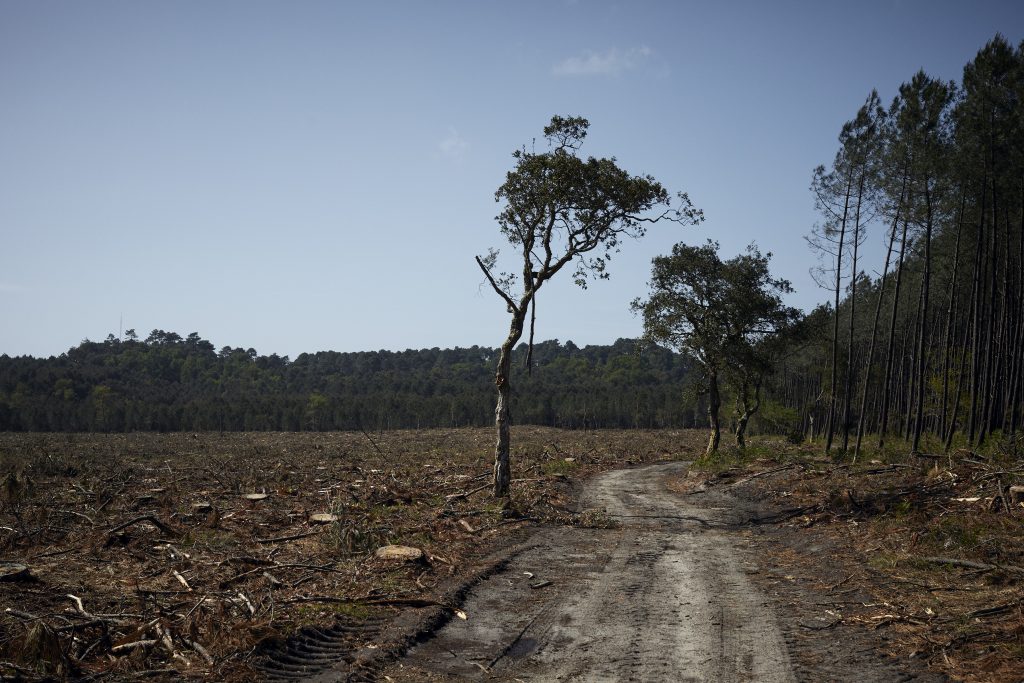
At one juncture I came upon two machines: a cutting and limbing machine and one used to stack logs. The entire cut-block could be serviced by only two people.
The path did not lead to the sea. It led to a golf course. I walked along the road that bisected it, hoping I would get the ocean, but it was too long, and eventually I had to turn around so as not to be too late in making dinner.
On the way back the sun was lower in the sky. Inside the trees it was hot and a bit airless now. The trees grow on sand, and these sands seem to shift and transform over time, over the cycles of cutting and regrowing. I took a wrong turn around a little valley and this brought me up around a kind of sand cliff. There were roads cut into the trees by big machines, machines which were now gone. It was a strange feeling, following the paths of these enormous but now invisible machines that cut through the forest like giant insects. These roads had a meandering, haphazard quality to them, so that they would twist and turn and then trail off into nothing. Where there weren’t trees there were gorse bushes, and I had to walk through a number of them to find the next winding road.
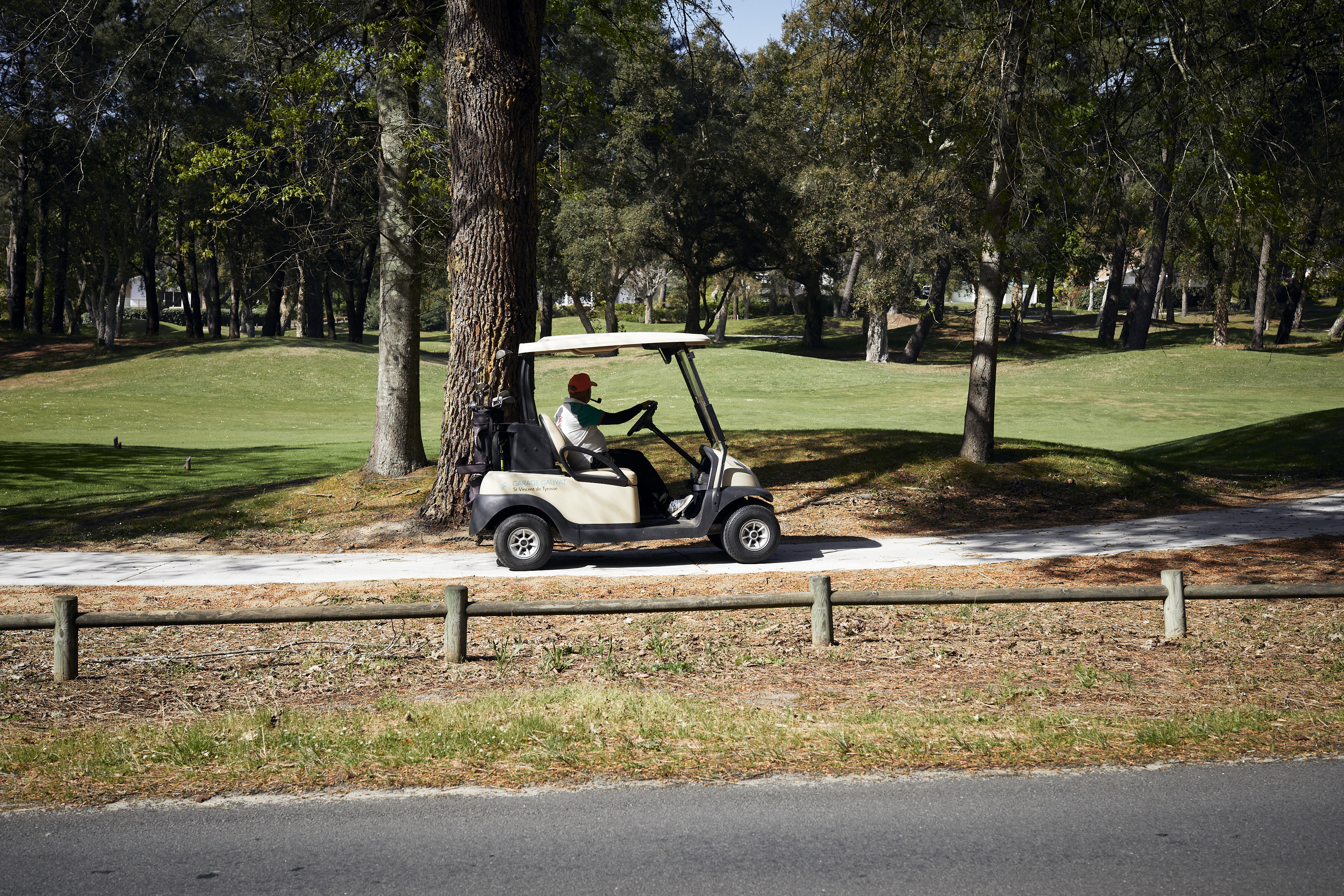
In France there are people everywhere. It is rare to be in a spot and see no one, or more precisely to see no evidence of buildings or habitation. Even in the parks and hiking in mountains numerous people pass by. This was one of the most empty places I have seen in France, with the least sign of human construction (even though this forest itself was a kind of human construction). The lack of people gave the space a sense of vastness, as though it perhaps went on forever. It is interesting how entirely a space can be transformed, the feeling of the space and its sense of scale, by the presence of even one other person, or by the sight of any buildings.
I felt lost, even though abstractly I knew I was not lost. I knew to follow my shadow. I knew that no road was far away. The air was windless now and the light took on a warm rust colour. I was surrounded by a total emptiness, a total stillness. I kept walking and eventually came out at the road in Pédebert, near the Point point P building materials store and the wine outlet. An unseen dog barked behind a fence. It was nearing dinnertime.
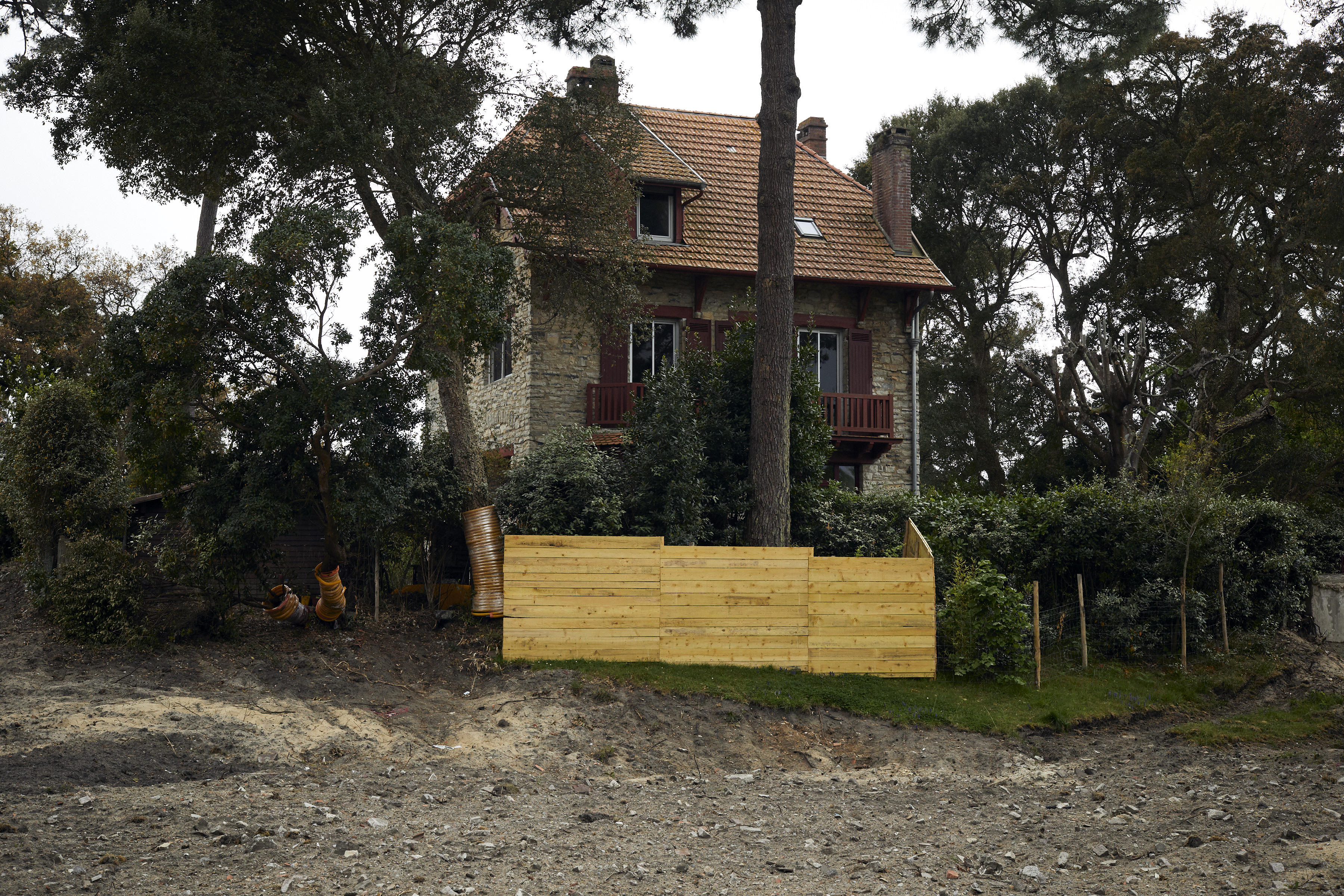
Web Design: Ali Bosworth
Photo Editing: Lise Latreille
Editors: David Ravensbergen & Daniel Horen Greenford
Neal Rockwell is a writer, photographer and filmmaker. He is currently completing a masters’ degree in Documentary Media at Ryerson University where he is exploring the effects of financialization on rental housing, as well researching the use of documentary power in the economy and the law, with the goal of strengthening documentary practice as a form of radical truth-telling.